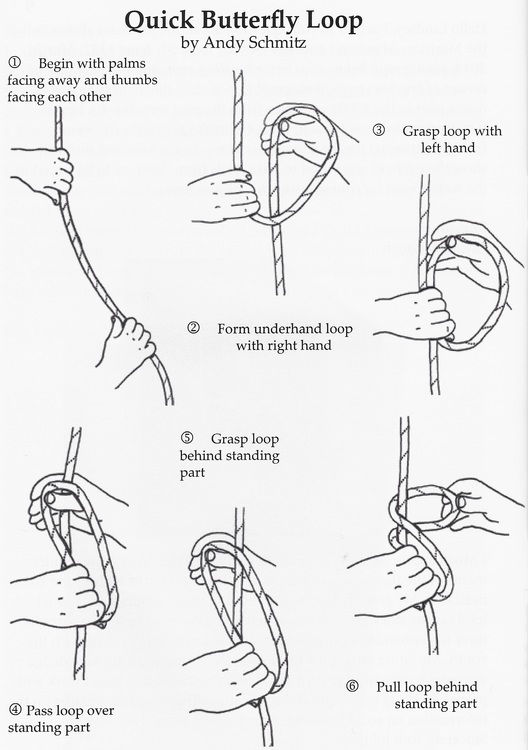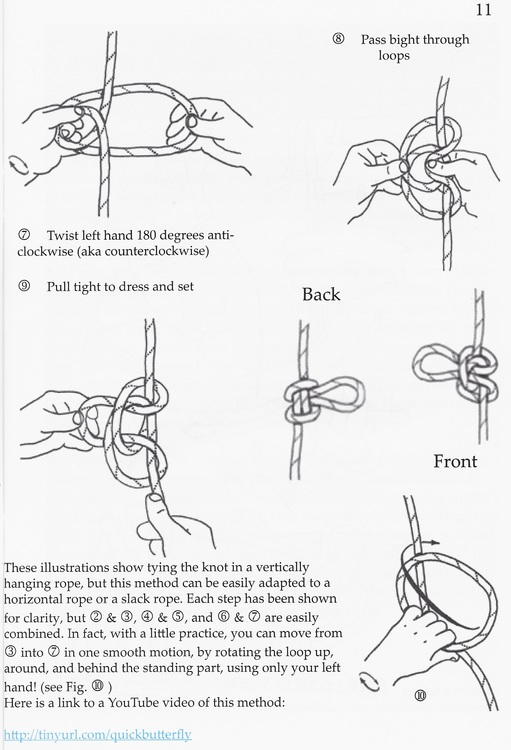Easy Way to Tie Alpine Butterfly Knot
- All Forums
-
General Climbing
A new method to tie the Alpine Butterfly Knot?
Follow topic:
Original Post
| knot rigger · Apr 21, 2015 · Unknown Hometown · Joined Apr 2015 · Points: 0 I may have discovered (invented?) a new way to tie an Alpine Butterfly. youtu.be/0wupL8dPTzw I feel it has some advantages over the traditional two methods: 1) speed Has anyone seed this method before? thanks Flag Quote | |
| Greg D · Apr 21, 2015 · Here · Joined Apr 2006 · Points: 883 Nice work. How long did it take to fix the rope above you though? Can you do it easily if tge rope is on the ground. Flag Quote | |
| aikibujin · Apr 22, 2015 · Castle Rock, CO · Joined Oct 2014 · Points: 300 Not in the exact same way, but I've seen a similar method on Youtube, basically a different sequence which arrives at the exact same rope and hand configuration as in this still: Butterfly Ok, check out this video: This is not exactly the video I had in mind, but it is the method I was thinking about. Your method starts out a little differently, but if you look at this still image, you arrive at the same rope and hand position before finishing the knot: Butterfly (thumb hook method) Flag Quote | |
| | rgold · Apr 22, 2015 · Poughkeepsie, NY · Joined Feb 2008 · Points: 526 Can't help with whether or not it is original, but I think it's cool. It avoids the twisting put into the knot strands by the standard "coiling" method. Greg, it is easily done with the rope on the ground. aikibujin wrote: I've seen a similar method on Youtube, basically a different sequence which arrives at the exact same rope and hand configuration as in this still. Yes, once you see the configuration in the still, it is easy to devise various ways to get there. Flag Quote |
| Greg D · Apr 22, 2015 · Here · Joined Apr 2006 · Points: 883 rgold wrote:Can't help with whether or not it is original, but I think it's cool. It avoids the twisting put into the knot strands by the standard "coiling" method. Greg, it is easily done with the rope on the ground. Yes, once you see the configuration in the still, it is easy to devise various ways to get there. Aren't you supposed to have dav test, citations and equations. My question was directed to the inventor and was rhetorical at best. But you took the bait. Congrats. Flag Quote | |
| knot rigger · Apr 22, 2015 · Unknown Hometown · Joined Apr 2015 · Points: 0 aikibujin: I was actually inspired by this video: posted by the same person at the "thumb hook" method video (and who's acquaintance i've now made online) Greg D: it's easily done with the rope on the ground (ie slack), or the rope horizontal as well. I've also tied it repeatedly with a bunch of rope weight under me, and it's still easy. Which is what I think the main advantage of this method is. Its easy to try at home, just tie off a coil with a 5' tail, pick up the coil by the tail and tie the knot :) it helps to anchor the standing end overhead, but you can tie the knot with the end loose as well. The hybrid, thumb hook, and traditional handwinding methods all are pretty difficult with a lot of rope weight below you. And I personally have always found the twist and fold method a challenge with a lot of rope weight. thanks for the input Flag Quote | |
| | wivanoff · Apr 22, 2015 · Northeast, USA · Joined Mar 2012 · Points: 638 I find this one is easiest for me to remember. Easy to make the loop as long as you need it. Key is making sure the rope tails "cross". Flag Quote |
| knot rigger · Apr 22, 2015 · Unknown Hometown · Joined Apr 2015 · Points: 0 wivanoff: That's another great video depicting the "hybrid" method. I have found that making large loops with that method is possible, but had the drawback of needing to pull great lengths of rope running over your hand. This is a relatively small critique, but if you ad that friction to the weight of rope below you, the hybrid method can be challenging. You can tie a large loop with my method without needing to have any of the rope run over your hand while tying it. He're what the author of the older "hybrid" video said about my method on another forum. "I think your method is well thought out. After a bit of playing around it became apparent that you have addressed what is perhaps the most important consideration regarding a vertically oriented line - that it can be under considerable tension - by virtue of it's own weight - where the knot is to be located. The method is only fully appreciated when much of the rope's weight hangs below, where the common "Handwrap" method is a fail. Your method has good flow and feels good in the hand - i.e. ergonomics - once one is familiar with it, which doesn't take long. Your method provides an effective means for isolating the weight of the rope without having to relieve the tension by means external to the tying process. Your method elegantly avoids unwanted friction during the tying process. Other methods require mitigation." I thought he put it pretty well, and was worth quoting, rather than paraphrasing. thanks Flag Quote | |
| aikibujin · Apr 22, 2015 · Castle Rock, CO · Joined Oct 2014 · Points: 300 knot rigger wrote:After a bit of playing around it became apparent that you have addressed what is perhaps the most important consideration regarding a vertically oriented line - that it can be under considerable tension - by virtue of it's own weight - where the knot is to be located. The method is only fully appreciated when much of the rope's weight hangs below, After thinking about your method for a while, I pretty much arrived at the same conclusion as this guy... just not in so many words. I think your method would be suprior to other methods in tying a butterfly knot on a hanging rope, for example, isolating a damaged section on a rappel line. I'm going to put it in my bag of tricks now, good job on coming up with it. As to whether to name it, I'll leave that to you. Usually knots are named but methods of tying are not... but then there are exceptions, figure-8 on a bight and re-threaded figure-8 come to mind. Flag Quote | |
| knot rigger · Apr 24, 2015 · Unknown Hometown · Joined Apr 2015 · Points: 0 I've learned that, as I strongly suspected, this method of tying the butterfly has been discovered before I did. It is known (if not well known) to some UK arborists as far back as at least 1998, and according to one of them, "well know" in mountaineering circles. In any case, it's useful, and deserved to be wider known. cheers Flag Quote | |
| | Michael M · Dec 27, 2018 · Rockville, MD · Joined May 2018 · Points: 160 I came across this method in Issue No. 128 of Knotting Matters (International Guild of Knot Tyers). Looks like it was discovered by another Andy -- what are the chances! Flag Quote |
lauderdalenatithem.blogspot.com
Source: https://www.mountainproject.com/forum/topic/110369396/a-new-method-to-tie-the-alpine-butterfly-knot







0 Response to "Easy Way to Tie Alpine Butterfly Knot"
ارسال یک نظر